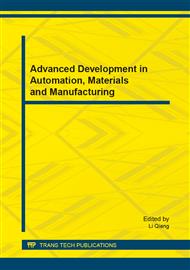p.449
p.454
p.460
p.465
p.469
p.473
p.477
p.481
p.485
Research on Artificial Intelligence Technology of Electrical Automation Control
Abstract:
Progress of society and human longevity require more developed productive forces and more intelligent human economic life in order to save precious human time. Innovation in the field of electrical automation control needs artificial human support, and artificial intelligence advantage in terms of automation and control in this area are indeed able to get great play. This paper describes the connotation and characteristics of artificial intelligence technology. As well as the status of electrical automation control artificial intelligence technology. The applications of artificial intelligence technology are analyzed and discussed in the electric automation industry. Electrical automated production widely uses artificial intelligence technology to improve the productivity of electronic devices, reduce the harsh production costs, and improve production efficiency and competitiveness, which is an important guarantee for long-term development. The applications of artificial intelligence technology promote the development and progress of automation and solve difficult control problems.
Info:
Periodical:
Pages:
469-472
Citation:
Online since:
August 2014
Authors:
Price:
Сopyright:
© 2014 Trans Tech Publications Ltd. All Rights Reserved
Share:
Citation:


